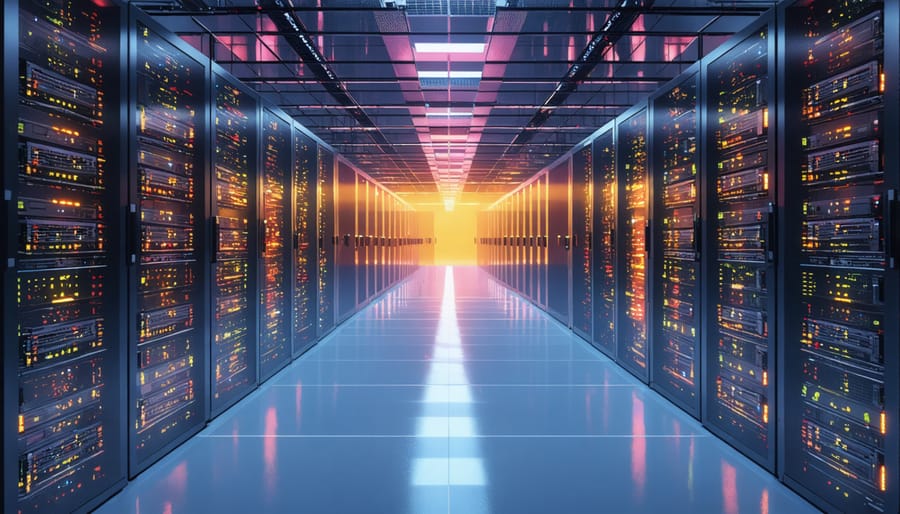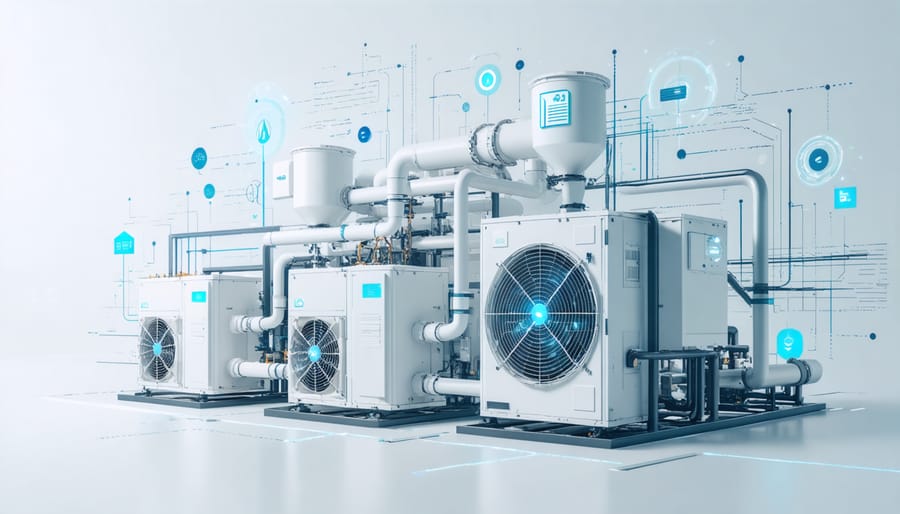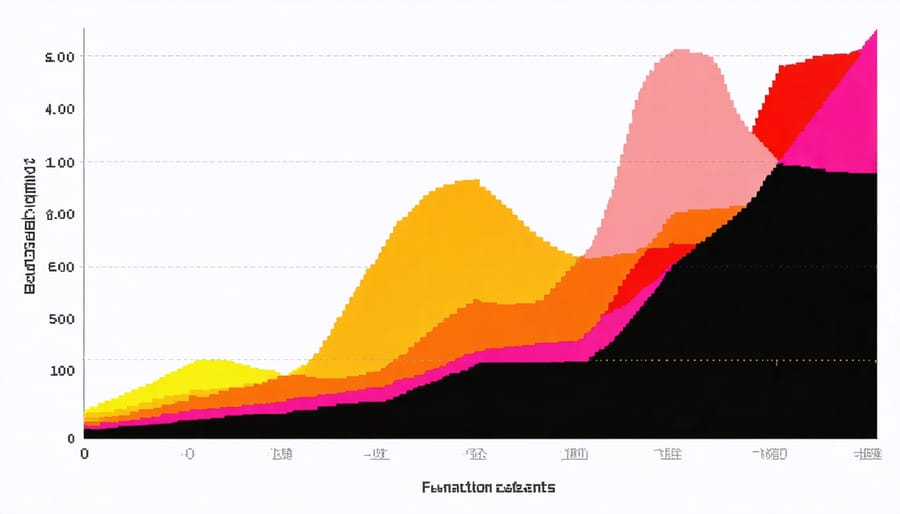In the race to maximize computing power, advanced thermal solutions have become the cornerstone of modern technology performance. As data centers and AI systems push processing boundaries, traditional cooling methods no longer suffice. Today’s thermal management systems combine artificial intelligence, advanced materials science, and predictive analytics to maintain optimal operating temperatures while reducing energy consumption by up to 40%.
The convergence of machine learning algorithms and thermal engineering has revolutionized how we approach heat management in high-performance computing environments. These smart systems continuously monitor thousands of data points, adjusting cooling parameters in real-time to prevent thermal throttling while maximizing energy efficiency. From phase-change materials that absorb excess heat to AI-driven liquid cooling systems that precisely target hotspots, the latest innovations are transforming thermal management from a passive necessity into an active performance enhancer.
For organizations pushing the boundaries of computing power, implementing advanced thermal solutions isn’t just about preventing system failures – it’s about unlocking new levels of processing capability while maintaining sustainability goals. These sophisticated cooling technologies represent the critical infrastructure enabling the next generation of artificial intelligence and high-performance computing applications.
Why Traditional Cooling Methods Fall Short
The Heat Challenge in AI Computing
Modern AI computing workloads create unique thermal challenges that traditional cooling solutions struggle to address. Unlike regular computing tasks, AI operations generate intense, fluctuating heat patterns due to their parallel processing nature and continuous computational demands.
Think of it like a car engine running at full throttle for extended periods – AI processors can reach temperatures that significantly impact their performance and lifespan. When training large language models or processing complex neural networks, these systems can generate heat spikes that are both more intense and less predictable than traditional computing tasks.
The challenge is particularly evident in data centers running AI applications, where processors might suddenly jump from idle to 100% utilization. This rapid temperature variation creates hot spots that can damage components and reduce efficiency. Additionally, the dense packaging of modern AI accelerators and GPUs means that heat builds up in smaller spaces, making traditional air cooling increasingly inadequate.
Understanding these thermal patterns is crucial for developing effective cooling solutions that can keep pace with AI’s growing computational demands while maintaining optimal performance and energy efficiency.

Limitations of Static Cooling Systems
Traditional cooling systems face significant challenges when dealing with modern computing workloads, particularly in AI and machine learning environments. These static solutions, designed for consistent heat loads, struggle to adapt to the dynamic nature of AI processing, where computational demands can spike dramatically within seconds.
Think of it like trying to cool a kitchen with a fixed-speed fan while constantly switching between cooking tasks. When you’re just chopping vegetables, you might not need much cooling, but when you suddenly fire up multiple burners, that same fan becomes inadequate. Similarly, static cooling systems can’t efficiently respond to the rapid changes in heat generation that occur during AI model training or inference operations.
The limitations become even more apparent in data centers, where traditional cooling methods often result in either overcooling (wasting energy) or undercooling (risking hardware damage). These systems lack the intelligence to predict thermal patterns or adjust cooling intensity based on workload variations, leading to reduced hardware lifespan and increased energy consumption. This inflexibility makes them increasingly unsuitable for modern computing environments where processing demands fluctuate constantly.

Smart Thermal Management Architecture
Predictive Temperature Monitoring
Modern data centers and computing environments rely on predictive temperature monitoring systems to maintain optimal operating conditions. These AI-powered solutions analyze historical temperature data, current system loads, and environmental factors to forecast potential thermal issues before they impact performance.
The system works by collecting real-time data from strategically placed sensors throughout the facility. Machine learning algorithms process this information alongside weather patterns, workload schedules, and equipment specifications to create accurate thermal predictions. When the AI detects a pattern that could lead to overheating, it automatically triggers preventive measures or alerts facility managers.
For example, if the system predicts a temperature spike in a particular server rack within the next hour, it can automatically adjust cooling parameters or redistribute workloads to prevent thermal stress. This proactive approach significantly reduces the risk of equipment failure and improves energy efficiency by optimizing cooling resources.
The benefits extend beyond just prevention. These systems learn and adapt over time, becoming more accurate in their predictions. They can identify seasonal patterns, equipment aging effects, and even subtle changes in thermal behavior that human operators might miss. This continuous learning ensures that cooling systems operate at peak efficiency while maintaining the ideal temperature for all computing equipment.
Dynamic Load Balancing
In modern computing environments, dynamic load balancing plays a crucial role in maintaining optimal thermal conditions across systems. Think of it as a smart traffic controller for computing tasks, constantly monitoring and redistributing workloads to prevent any single component from overheating.
When AI systems detect that certain processors or components are approaching their thermal limits, they automatically shift tasks to cooler areas of the system. This intelligent distribution not only prevents thermal throttling but also maximizes overall system performance. For example, if a GPU cluster is running complex calculations and some units begin to heat up, the system will redistribute the workload to cooler GPUs, ensuring consistent processing speeds while maintaining safe operating temperatures.
The real magic happens in real-time adaptation. Modern load balancing systems use predictive analytics to anticipate thermal hotspots before they occur. By analyzing historical performance data and current workload patterns, these systems can make preemptive adjustments to task distribution, ensuring smooth operation even during peak processing demands.
This approach has shown remarkable results in data centers, where proper load distribution can reduce cooling costs by up to 30% while maintaining or even improving processing efficiency. The key is finding the sweet spot between performance and thermal management, creating a self-regulating ecosystem that optimizes both aspects simultaneously.
Adaptive Cooling Algorithms
Machine learning has revolutionized how modern cooling systems operate, transforming them from static, preset configurations into dynamic, self-optimizing solutions. These adaptive cooling algorithms continuously analyze data from multiple temperature sensors, workload patterns, and environmental conditions to make real-time adjustments to cooling parameters.
The learning process begins with the algorithm collecting historical performance data, including heat generation patterns, cooling efficiency metrics, and power consumption rates. This data trains the system to recognize optimal cooling responses for different scenarios. As the system operates, it builds a sophisticated understanding of the relationship between various factors affecting thermal management.
For example, in a data center environment, the algorithm might notice that certain server racks generate more heat during specific times of day. It can then proactively adjust cooling resources before temperatures rise, rather than reacting after the fact. This predictive capability significantly improves energy efficiency while maintaining ideal operating temperatures.
The algorithms also adapt to changes in the cooling system’s physical environment. If air flow patterns change due to equipment modifications or the addition of new hardware, the system automatically recalibrates its cooling strategy. This continuous optimization process ensures that cooling resources are always used in the most efficient manner possible.
Most importantly, these adaptive systems learn from their own performance over time, constantly refining their cooling strategies to achieve better results with less energy consumption. This self-improving capability makes them particularly valuable for complex computing environments where thermal management is critical.
Real-World Implementation Benefits
Energy Efficiency Gains
The implementation of AI-driven thermal management solutions has led to remarkable improvements in energy efficiency optimization, with data centers reporting power usage effectiveness (PUE) reductions of up to 40%. These gains are particularly significant when considering that cooling systems typically account for 30-40% of a data center’s total energy consumption.
Real-world deployments have demonstrated consistent cost savings across various computing environments. For example, a major cloud provider implemented machine learning-based thermal control systems and achieved a 15% reduction in cooling costs within the first year. Similarly, enterprise data centers utilizing AI-powered thermal solutions have reported annual energy savings ranging from $200,000 to $500,000 for every 10,000 square feet of computing space.
The efficiency improvements extend beyond direct power consumption. Modern thermal solutions have shown a 25% increase in hardware lifespan due to more stable operating temperatures, reducing replacement costs and electronic waste. Additionally, these systems have demonstrated the ability to maintain optimal performance while reducing fan speeds by up to 30%, resulting in decreased noise levels and improved working conditions.
These quantifiable benefits make a compelling case for the adoption of advanced thermal management systems, especially as computing demands continue to grow and energy costs rise.

Extended Hardware Lifespan
Effective thermal management plays a crucial role in extending the lifespan of computing hardware by preventing thermal stress and component degradation. When processors and other components operate at optimal temperatures, they maintain their performance capabilities while significantly reducing the risk of premature failure.
Consider a high-performance computing system running complex AI workloads. Without proper thermal management, these systems might experience thermal throttling, where the processor automatically reduces its speed to prevent overheating. This not only impacts immediate performance but also leads to long-term wear and tear on the components. Advanced thermal solutions help maintain consistent operating temperatures, allowing systems to run at peak performance without compromising longevity.
The financial implications of extended hardware lifespan are substantial. Organizations can delay expensive hardware replacements, reduce maintenance costs, and minimize system downtime. For instance, a data center implementing advanced cooling solutions might extend their server lifespan by 2-3 years, representing significant cost savings across their infrastructure.
Modern thermal solutions also contribute to component stability. By maintaining consistent temperatures, they reduce thermal expansion and contraction cycles that can stress circuit boards, solder joints, and other critical components. This stability is particularly important in environments where hardware reliability is paramount, such as in AI training clusters or mission-critical systems.
Regular temperature monitoring and proactive thermal management become investments in hardware longevity, ensuring that expensive computing infrastructure delivers maximum value throughout its operational life.
Future Developments
Next-Generation Cooling Technologies
The future of thermal management is rapidly evolving with groundbreaking innovations that promise to revolutionize how we cool electronic systems. Quantum cooling technologies are emerging as a potential game-changer, utilizing quantum effects to achieve unprecedented cooling efficiency at the nanoscale level. These systems could potentially maintain stable temperatures in quantum computers and other advanced computing systems.
Graphene-based cooling solutions are another promising development, leveraging the material’s exceptional thermal conductivity properties. When combined with traditional cooling methods, graphene-enhanced systems can dissipate heat up to 60% more effectively than current solutions.
Phase-change materials (PCMs) are also gaining traction, offering smart temperature regulation by absorbing and releasing heat at specific temperature thresholds. These materials can be integrated into cooling systems to provide passive thermal management without requiring additional energy input.
Perhaps most exciting is the development of self-healing thermal interfaces, which can automatically repair microscopic gaps and maintain optimal thermal contact over time. This technology could significantly extend the lifespan of cooling systems while reducing maintenance requirements.
Integration with Green Computing
AI-driven thermal solutions play a crucial role in supporting green computing initiatives by optimizing energy consumption and reducing the environmental impact of data centers and computing systems. These intelligent cooling systems use machine learning algorithms to predict and manage heat distribution, resulting in up to 40% reduction in cooling energy usage compared to traditional methods.
Smart thermal management systems contribute to sustainability in several ways. They dynamically adjust cooling resources based on real-time workload demands, preventing energy waste from overcooling. By maintaining optimal operating temperatures, these solutions also extend hardware lifespan, reducing electronic waste and the need for frequent replacements.
Modern AI thermal solutions incorporate features like predictive maintenance and adaptive power management, which work together to minimize carbon footprint. For instance, some systems can automatically shift computing loads to cooler zones or schedule intensive tasks during periods when ambient temperatures are lower, maximizing natural cooling opportunities.
The integration of these solutions with renewable energy systems further enhances their green computing credentials, creating a synergistic approach to sustainable data center operations. This alignment with environmental goals makes AI thermal management an essential component of modern eco-friendly computing infrastructure.
As we look toward the future of computing, AI-driven thermal solutions stand at the forefront of innovation, promising to revolutionize how we manage heat in electronic systems. These advanced solutions represent more than just technological improvements; they embody a fundamental shift in our approach to thermal management, combining real-time monitoring, predictive analytics, and autonomous decision-making.
The integration of artificial intelligence in thermal management has already demonstrated significant improvements in energy efficiency, system longevity, and performance optimization. By continuously learning from operational patterns and environmental conditions, these systems adapt and evolve, providing increasingly sophisticated cooling strategies that traditional static solutions simply cannot match.
Looking ahead, we can expect AI-driven thermal solutions to become even more crucial as computing demands continue to grow. The rise of quantum computing, edge computing, and increasingly powerful data centers will require ever more sophisticated cooling approaches. AI’s ability to optimize thermal management in real-time while predicting and preventing potential issues will be instrumental in supporting these technological advances.
Moreover, these intelligent thermal solutions will play a vital role in sustainable computing initiatives, helping organizations reduce their carbon footprint while maintaining optimal performance. As we continue to push the boundaries of computational power, the symbiosis between AI and thermal management will become not just advantageous but essential for the future of technology.

